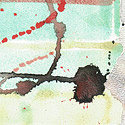On Beauty
The hill I walked up and down to school while I got a writing degree in Ithaca, NY, was called Gun Hill. It was named for the enormous hulk of disused factory, which sat across the street from glossy apartment buildings like a transplanted piece of inner-city Detroit. My life crystallized in its third-story windows: It was fall when I was first stopped in my tracks, in the late afternoon. I could see all the way down onto the lake through those corner windows, bright as molten metal. The whole top corner of the building was a burning eye. It was the seeing-through that held me, so tight I could hardly breathe. It was also the promise come true: I'd always known this building was beautiful, with its scarred face.
A year later my friend Anja, from Germany (where I was born and lived until I was sixteen) came to visit me. I tried to tell her about the factory, finally blurting, "It's beautiful. That's the thing—that's what I've been realizing about myself—my longing for beauty directs me, at a level so deep I don't even know it sometimes." This was an epiphany to me. So I was startled when she gave me a disbelieving look and said, "Of course! Nothing about you is more obvious."
Beauty, I had grown up believing, was a nice thing, but not a very strong or reliable one. It was good for decorating walls, but it was not something to put your weight down on; it didn't necessarily tell the truth. Slowly, through teachers like the artist Makoto Fujimura, I found language for beauty as something that goes straight to the heart of reality, and more than that, to the meaning of reality. Beauty is a promise that what is torn can be made whole, that we are living toward a God whose power is not the power of antiseptic justice, but the power of the place where beauty and justice meet. God is so just that we can't look straight at Him; God is so beautiful that once we catch a glimpse, we can't look away.
There is a term in Japanese aesthetics called mono no aware, which describes beauty and suffering as inextricably linked. There is a term in the Hebrew scriptures, shalom, which translates as "peace" and means a dancing balance, a give and take that never exploits—everything in living, breathing, good relationship.
These two, beauty and shalom, are what I want to turn toward and follow, with my whole life. Many of these paintings are full of torn silver leaf, because beauty has met me most powerfully in points of tearing. But they are also harmonious in a way that would not be possible if I did not believe we can live, in what is torn, toward shalom—a wholeness like the wholeness of Christ's resurrected body, which is neither beautiful in spite of its wounds, nor because of them, but in them.



















































